Help and Support
Before you get started
- Make sure your broadband connection is up and running before you set up your router - we'll contact you (via email and text message if we have your mobile number) when it's ready
- Broadband works best when your router is connected to the master telephone socket (it's usually the one closest to where your phone line enters your home)
- Your router can get too warm if air can't flow around it. Try to avoid putting it under a desk, on a carpet/other fabric, or behind large objects
- If you're going to use wireless, try to place your router close to where you'll be using broadband the most. Thick walls, concrete floors and large metal surfaces can weaken the wireless signal, so try to avoid these where possible
- We recommend leaving your router switched on all the time (even if you're not using it). If you can, connect it to an unused power socket and make sure that it won't be switched off with other items
- What's in the box?
- Connect your microfilters
- Connect your router
- Connect your computer
- Get online
- Troubleshooting
1. What's in the box?
2. Connect your microfilters
Microfilters already plugged in? Go to part 3 and connect your router.
Plug a microfilter into each telephone socket you use in your property. If you had to unplug something you can plug it back into the Phone socket of the microfilter.
Phone sockets can be used by phones, alarm systems, fax machines and digital TV boxes, so make sure you don't miss anything out. Microfilters are essential for keeping your phone and Internet services from interfering with each other. Without microfilters you'll see poor speeds and connection drops.
- You can use a microfilter before or after an extension lead, but not both
- You can connect two devices to one microfilter if you use a phone adapter
- If you need more microfilters, you can get them from most electrical stores and supermarkets
- Don't plug a microfilter into the socket of another microfilter
For more help with this, please see Guide to fitting Microfilters.
3. Connect your router
-
Extend the feet on the bottom of the router and make sure it's steady when you stand it up.
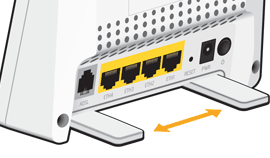
-
Assemble the power adapter by sliding the three pin plug onto the main unit until it clicks into place.
Plug the power cable into the back of your router and the other end into a power socket.
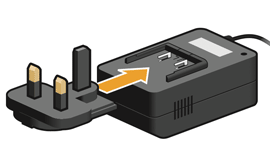
-
Plug the Internet cable into the ADSL socket on the back of the router.
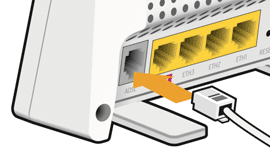
-
Plug the Internet cable (grey ends) into the microfilter socket marked DSL
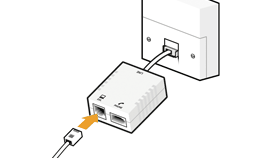
-
The Broadband light will flash, wait for it to turn green before you continue (this can take up to 5 minutes).
If the Broadband light doesn't turn green, please see our Connection troubleshooting guide.
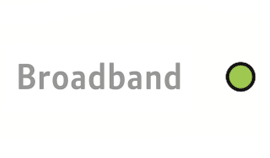
4. Connect your computer
When setting up for the first time, we think it's easier to use the Ethernet cable. This way you can make sure everything is working and you'll be online in no time.
If using the Ethernet cable isn't convenient or you'd prefer to use wireless right away, please see our Wi-Fi connection guides (remember to return here and follow part 5 when you're done!)
How to connect using the Ethernet cable
-
Plug the Ethernet cable (yellow ends) into one of the 4 yellow Ethernet sockets on the back of your router.
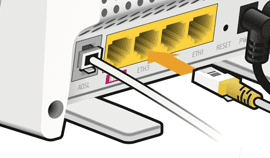
-
Plug the other end of the Ethernet cable into your computer's Ethernet socket. The Ethernet light on the router will turn green or flash.
Your computer is now connected to your router, please go to part 5.
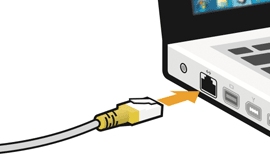
5. Get online
You're nearly there! At this point your router should be plugged in, switched on and connected to your telephone line and computer or device.
If the Broadband light is NOT green, please see our Connection troubleshooting guide. When the Broadband light turns green, remember to return to this guide and follow the next steps.
-
Make yourself a tea or coffee and don't touch your computer or router for 15 minutes.
(Don't try to use the Internet while you're waiting, as your router might still be setting itself up)
-
After 15 minutes, open your computer's web browser (e.g. Internet Explorer, Safari or Firefox).
And that's it. You should see your web browser's home page - congratulations! You're now connected and able to browse the Internet
6. Troubleshooting
If you're having problems connecting, look at the lights on the front of your router and follow the appropriate instructions.
If the Broadband light on the router is flashing
This means there's a problem with your broadband signal. If you're setting up for the first time, make sure we've confirmed that your broadband service is ready. If it is, check your microfilters and the connection between the router and your phone socket. If the Broadband light won't stop flashing, please follow the steps in our Connection troubleshooting guide.
If the Broadband and Internet lights are green but you see a 404 error message
This means that your router is connected to the Internet but your computer or device is not connected to the router. Check and follow the connection instructions in step 4 (for wired connections) or our Wi-Fi connection guides and try again.
If the Broadband and Internet lights are green but you can only access the 'Broadband Setup' page
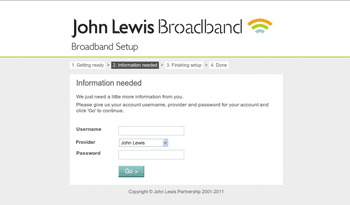
This means that you've set everything up correctly but your router hasn't finished the easy setup process. Follow the steps shown below to get connected.
- If you're setting up for the first time (or following a factory reset), close your web browser and try again in 15 minutes.
- If you're still seeing this screen after 15 minutes, enter your Account Username and password (the ones you use to log into this site).
- Check your Provider in the drop-down list and change it if you need to.
- Click Go - after a few minutes you'll see a large green tick, which means you're connected to the Internet.
Your Account username if you've moved from Greenbee or Waitrose Broadband
Your username if you've moved from Greenbee or Waitrose broadband
Your username won't change. It'll look like one of the examples shown below.
Greenbee
Your username will look like <your username>@greenbee.net (e.g. smith@greenbee.net).
Waitrose
Your username will look like <your username>@waitrose.com (e.g. smith@waitrose.com).
Having problems with your broadband connection?
Report a problem with your service. It's faster by text.
Service Status
For full details of our current issues or any maintenance work that could be affecting your service please visit our Service Status site.
Can't find what you're looking for?
If we've not been able to address your query through a support article please contact Customer support for further assistance.
